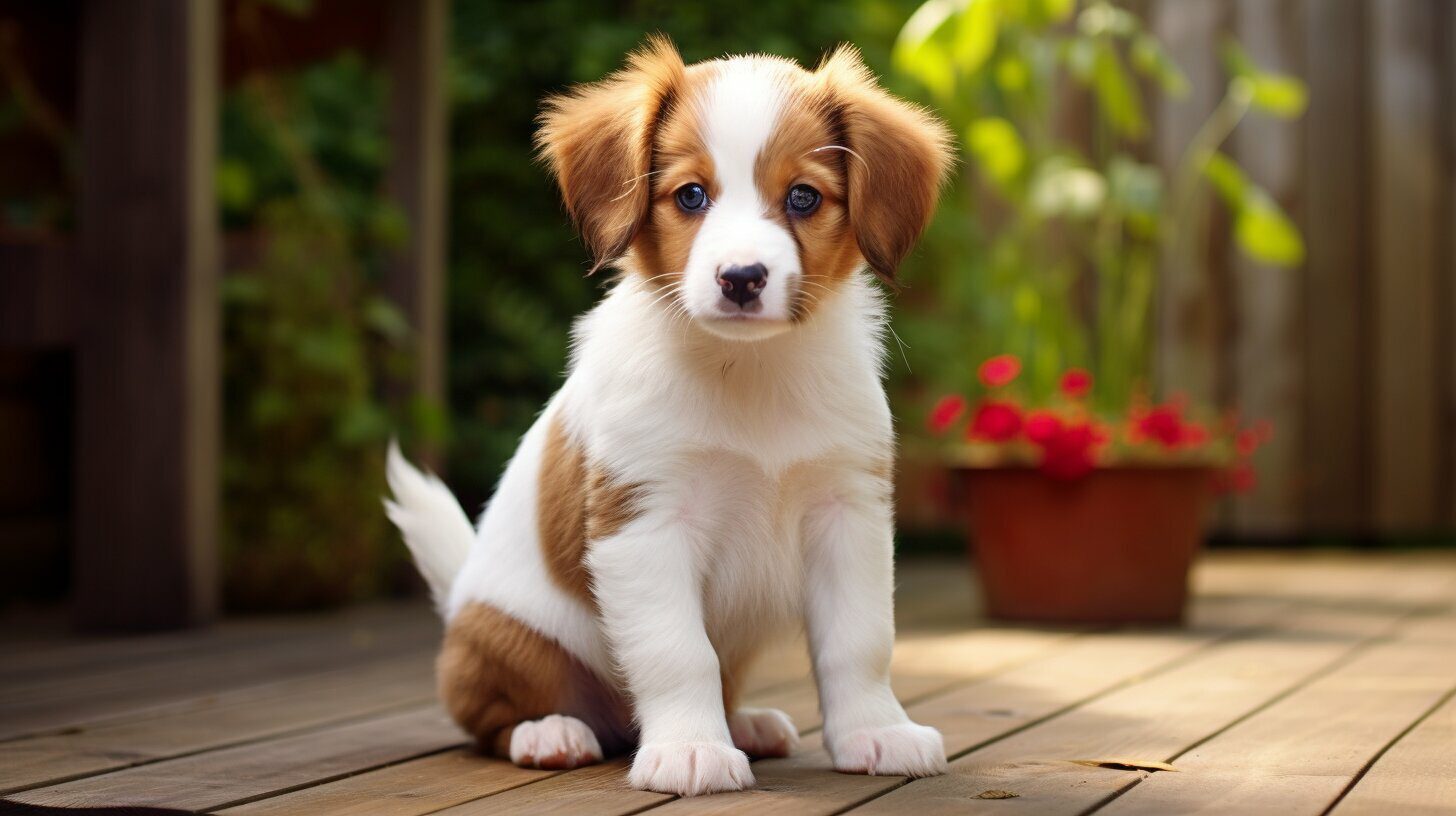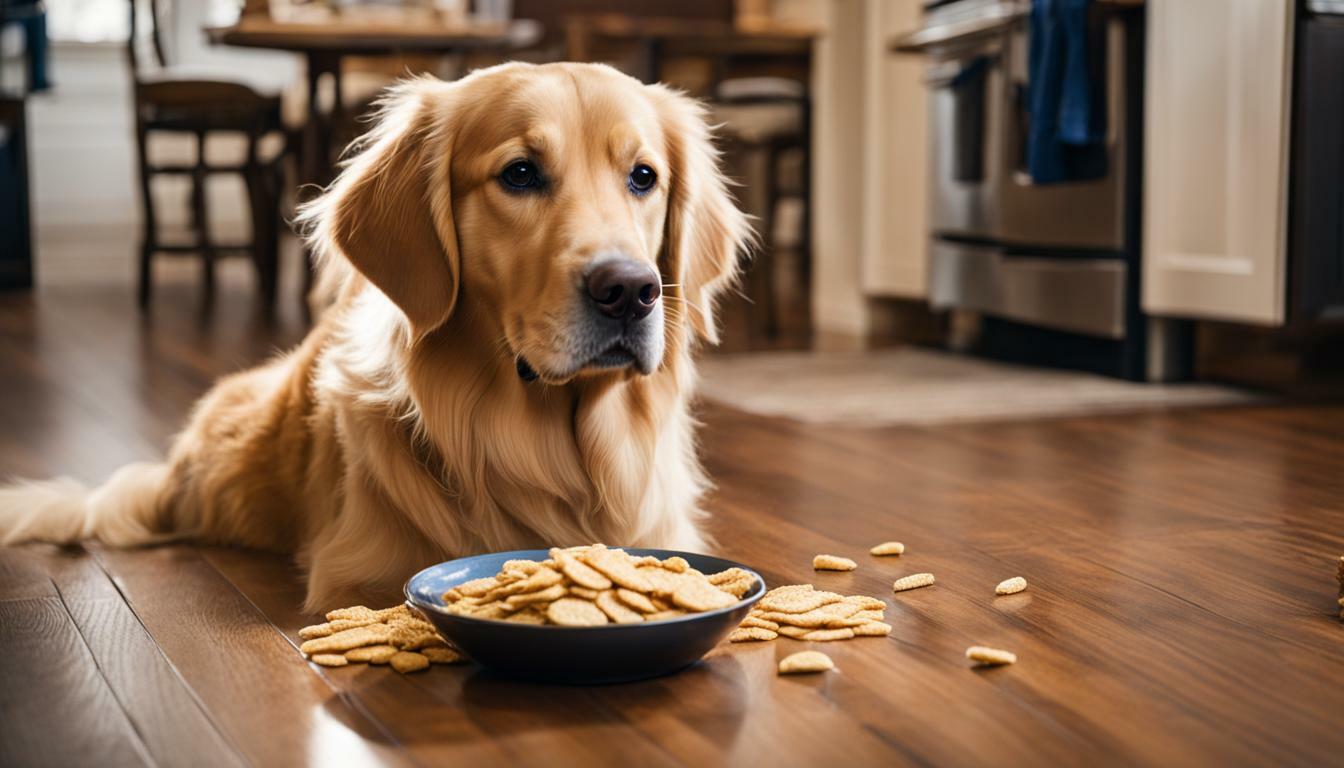
If you’ve ever wondered, “Can dogs eat Wheat Thins?” you’ve come to the right place. As a responsible pet owner, it’s important to know what foods are safe to share with our furry friends. Wheat Thins, a popular snack among humans, may seem tempting to offer to your four-legged companion. However, it’s essential to understand the potential risks and implications before doing so.
- While Wheat Thins are not toxic to dogs, they can have negative health impacts over time.
- They contain high amounts of sodium, which can lead to elevated blood pressure, electrolyte imbalance, and hypernatremia in dogs.
- Wheat can also cause allergies in some dogs, resulting in itchy skin, hair loss, and other symptoms.
- Sugar, artificial preservatives, and colorings in Wheat Thins are not beneficial for dogs and can contribute to health issues like obesity.
- Dogs should only be given very small quantities of Wheat Thins as an occasional treat or healthier alternatives should be considered.
While it may be tempting to share your favorite snack with your dog, it’s important to prioritize their health and well-being. If you choose to offer Wheat Thins to your furry friend, it’s crucial to do so in moderation and be mindful of their overall diet. Remember, consulting with a veterinarian is always a good idea if you have any concerns or questions about your dog’s dietary needs.
The Potential Risks of Feeding Wheat Thins to Dogs
While Wheat Thins are not toxic to dogs, there are some risks worth considering before sharing this snack with your furry companion. These crispy crackers contain high levels of sodium, which can have negative health impacts on dogs over time. Excessive sodium consumption can lead to elevated blood pressure, electrolyte imbalance, and even hypernatremia.

In addition to the sodium content, Wheat Thins also contain wheat, which can cause allergies in certain dogs. Symptoms of wheat allergies can include itchy skin, hair loss, digestive issues, and more. It’s important to be mindful of these potential allergic reactions if you’re considering giving Wheat Thins to your furry friend.
Furthermore, it’s worth noting that Wheat Thins contain sugar, artificial preservatives, and colorings. These additives are not beneficial for dogs and can contribute to health issues such as obesity. It’s always best to provide dogs with a balanced, nutrient-rich diet tailored to their specific needs, rather than relying on processed snacks like Wheat Thins.
To keep your dog’s well-being in mind, it’s recommended to only offer very small quantities of Wheat Thins as an occasional treat. Alternatively, you can explore healthier alternatives that are safe and suitable for canine consumption. Remember, moderation is key when it comes to treating your furry friend to human snacks.
Sodium Content and Health Concerns
Dogs and their sodium intake should be carefully monitored, and Wheat Thins can contribute to potential health concerns in this regard. Sodium is an essential mineral for dogs, but excessive consumption can lead to various health issues. Wheat Thins, like many processed snacks, contain high levels of sodium, which can have negative effects on a dog’s overall well-being.
Excessive sodium intake can cause elevated blood pressure in dogs, leading to hypertension. This can put a strain on their circulatory system and potentially result in heart problems. Additionally, sodium plays a crucial role in maintaining electrolyte balance in the body. When dogs consume too much sodium, it can disrupt this balance, leading to electrolyte imbalances that can have detrimental effects on their health.
Hypernatremia, which refers to high levels of sodium in the blood, can also occur if dogs consume excessive amounts of sodium. This condition can cause dehydration, increased thirst, and even neurological symptoms such as seizures. It is essential to note that some dog breeds, such as those with heart or kidney conditions, are more susceptible to the negative impacts of sodium consumption.
| Sodium Content in Wheat Thins (per serving) | Recommended Daily Sodium Intake for Dogs* |
|---|---|
| 210mg | 100mg – 300mg** |
*Recommended daily sodium intake for dogs varies based on factors such as age, weight, and overall health. Consult with your veterinarian for specific dietary recommendations.
**The recommended daily sodium intake for dogs is typically lower for dogs with certain health conditions or special dietary needs.
Given the potential risks associated with excessive sodium intake, it is crucial to limit the amount of Wheat Thins or any other high-sodium snacks that dogs consume. Instead, focus on providing a balanced, nutritious diet that meets your dog’s specific dietary needs. If you have concerns about your dog’s sodium intake or notice any abnormal symptoms, consult with a veterinarian for proper guidance and advice.
Wheat Allergies in Dogs
While some dogs may have no issues with wheat, others can develop allergies that may cause discomfort and health problems if exposed to Wheat Thins. Wheat allergies in dogs can manifest in various ways, including itchy skin, hair loss, gastrointestinal issues, and respiratory problems. If your dog displays any of these symptoms after consuming Wheat Thins, it is important to consult a veterinarian for proper diagnosis and guidance.
If your dog is allergic to wheat, it is essential to avoid feeding them Wheat Thins or any other products containing wheat. Instead, opt for dog-friendly snacks that are free from wheat and other common allergens. There are several healthier alternatives available in the market that can still provide your furry friend with a tasty treat without the risk of triggering allergies.
Dogs should only be given very small quantities of Wheat Thins as an occasional treat, or healthier alternatives should be considered.
It is important to note that not all dogs will have allergic reactions to wheat or Wheat Thins. However, if your dog has a known wheat allergy or displays any symptoms after consuming wheat-based products, it is best to err on the side of caution and avoid feeding them these snacks.

| Common Symptoms of Wheat Allergies in Dogs: |
|---|
| Itchy skin |
| Hair loss |
| Ear infections |
| Gastrointestinal issues (vomiting, diarrhea) |
| Respiratory problems (coughing, sneezing) |
Conclusion:
While some dogs may tolerate wheat and Wheat Thins without any issues, it is important for pet owners to be aware of potential allergies that can arise. If your dog has a history of allergies or displays symptoms after consuming wheat products, it is advisable to avoid feeding them Wheat Thins. Opt for dog-friendly snacks that do not contain wheat or other common allergens to ensure your furry friend stays healthy and comfortable.
The Impact of Sugar, Preservatives, and Colorings
When considering giving your dog Wheat Thins, it’s important to consider the potential negative impact of added sugars, preservatives, and artificial colorings. These ingredients, commonly found in processed snacks like Wheat Thins, can have detrimental effects on your furry friend’s health.
Sugar is often added to enhance the taste of snacks, but it offers no nutritional value for dogs. Consuming excessive amounts of sugar can lead to weight gain, obesity, and dental issues. Additionally, artificial preservatives and colorings used in Wheat Thins can be problematic for dogs, as they have been linked to allergic reactions and digestive problems.
To illustrate the impact of these additives, here is a table that highlights the common sugars, preservatives, and colorings found in Wheat Thins:
| Additives | Potential Effects |
|---|---|
| Sugar | Promotes weight gain, dental issues |
| Artificial Preservatives | Allergic reactions, digestive problems |
| Artificial Colorings | Possible allergic reactions |
As responsible pet owners, it is crucial to prioritize your dog’s health and well-being. Instead of relying on wheat-based snacks like Wheat Thins, consider offering healthier alternatives. There are various dog-friendly snacks available that contain natural ingredients without the harmful additives found in processed snacks.
Remember, moderation is key when treating your dog with snacks. Wheat Thins should only be given in very small quantities and should never replace a balanced and nutritious diet. If you notice any adverse reactions or your dog consumes a large amount of Wheat Thins, it is always best to consult your veterinarian to ensure your pet’s health and safety.
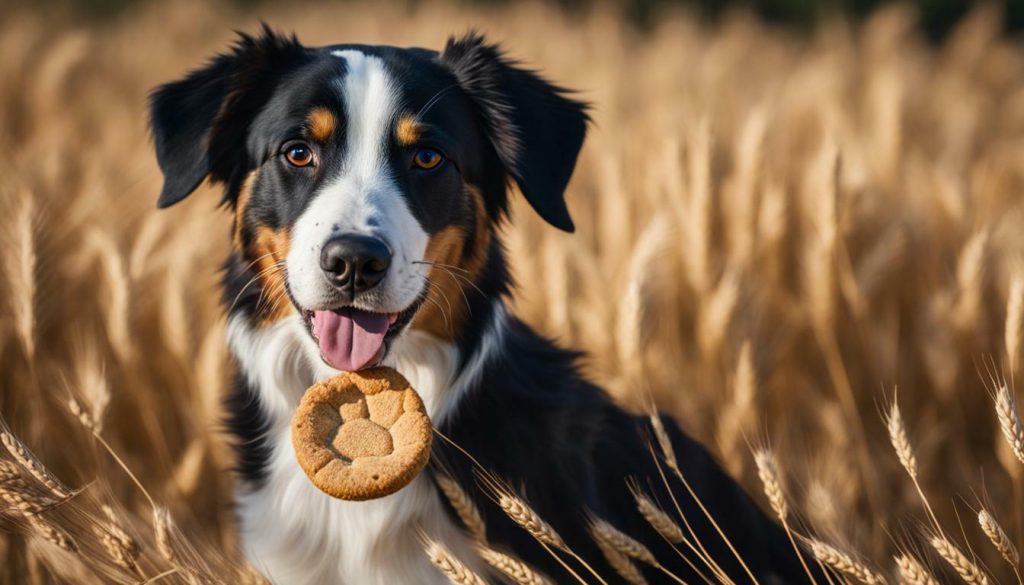
While Wheat Thins can be enjoyed by dogs in moderation, it’s crucial to understand the appropriate portion sizes and frequency to maintain their overall health. These popular snacks may not be toxic to dogs, but they do come with certain risks and drawbacks that pet owners should be aware of. Feeding Wheat Thins to your furry friend should be done sparingly and with caution.
When it comes to portion sizes, it’s important to remember that dogs have different nutritional needs than humans. A small piece of Wheat Thin can be a tasty treat, but too much can lead to health issues, especially due to its high sodium content. Dogs are more sensitive to sodium than humans, and excessive consumption can result in elevated blood pressure, electrolyte imbalance, and even hypernatremia.
In addition to the high sodium content, Wheat Thins also contain wheat, which can potentially cause allergies in some dogs. Common symptoms of wheat allergies include itchy skin, hair loss, digestive issues, and ear infections. It’s essential to monitor your dog for any signs of discomfort or allergic reactions if you choose to give them Wheat Thins.
Furthermore, the added sugar, artificial preservatives, and colorings in Wheat Thins are not beneficial for our canine companions. These additives can contribute to health issues such as obesity and digestive problems. Therefore, it’s important to consider healthier alternatives for your dog’s snacking needs.
Remember, the key is moderation. Instead of relying solely on Wheat Thins, consider offering your dog a variety of dog-friendly snacks that are more nutritionally balanced. You can opt for natural treats like apple slices, carrots, or even homemade dog biscuits. These alternatives are not only healthier but also allow you to have more control over the ingredients your dog consumes.
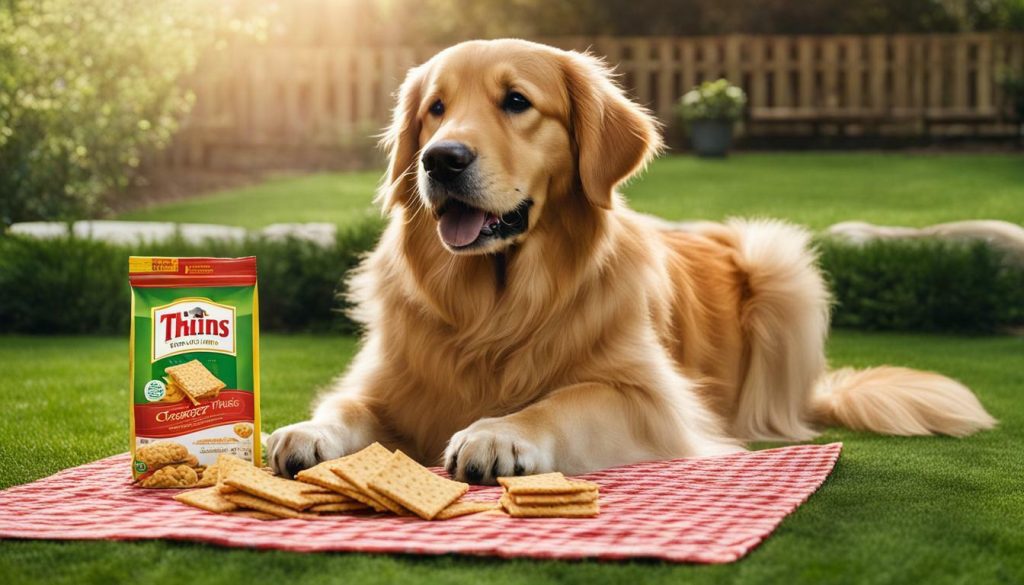
| Treat Options | Benefits |
|---|---|
| Apple Slices | Natural, low in calories, and a good source of vitamins A and C |
| Carrots | Crunchy, low in calories, and rich in vitamins and fiber |
| Homemade Dog Biscuits | Allows control over ingredients, can be tailored to your dog’s dietary needs |
Ultimately, it’s important to prioritize your dog’s health and make informed choices about their diet. While an occasional Wheat Thin treat may not cause immediate harm, it’s best to be mindful of the potential risks associated with these snacks. Remember to consult a veterinarian if your dog consumes a large amount of Wheat Thins or experiences any abnormal symptoms. By maintaining a balanced and nutritious diet, you can ensure that your furry friend stays happy and healthy for years to come.
Healthier Alternatives to Wheat Thins
If you’re looking for healthier snack options for your four-legged companion, there are plenty of alternatives available that can provide the same level of enjoyment without the potential risks associated with Wheat Thins. While it’s important to remember that dogs have different dietary needs than humans, there are still dog-friendly snacks that can satisfy their cravings.
| Healthy Snack | Benefits |
|---|---|
| Carrot sticks | Low in calories and high in fiber, carrots are a great crunchy treat that can help keep your dog’s teeth clean. |
| Peanut butter-filled Kong toy | A classic favorite among dogs, a Kong toy filled with peanut butter provides mental stimulation and a long-lasting snack. |
| Blueberries | Packed with antioxidants, blueberries offer a sweet and nutritious snack for dogs. They can be served fresh or frozen. |
Remember to always choose dog-friendly snacks that are safe for consumption. Avoid giving your dog foods that are toxic to them, such as chocolate, grapes, or onions. It’s also important to consider portion control and not overfeed your furry friend. Treats should only make up a small portion of their overall diet, as excess calories can lead to weight gain and health issues.
“It’s always best to consult with your veterinarian about the specific dietary needs of your dog.”
By opting for healthier alternatives, you can ensure that your dog is getting the nutrients they need without the potential negative impacts of processed snacks like Wheat Thins. Remember, a happy and healthy dog is a well-fed dog!

If your dog consumes a significant amount of Wheat Thins or displays any unusual symptoms after eating this snack, it’s advisable to seek guidance from your veterinarian. While Wheat Thins are not toxic to dogs, they can have negative health impacts over time due to their high sodium content and potential for triggering allergies.
Excessive consumption of Wheat Thins can lead to elevated blood pressure, electrolyte imbalance, and hypernatremia in dogs. These conditions can cause various health issues and discomfort for your furry friend. It’s essential to pay attention to any signs of distress or abnormal behavior after your dog has consumed Wheat Thins.
Allergies to wheat can also be a concern for some dogs. If your dog experiences symptoms such as itchy skin, hair loss, gastrointestinal upset, or respiratory issues after eating Wheat Thins, it may indicate an allergic reaction. In such cases, it’s crucial to consult your veterinarian to determine the best course of action.
Signs to Watch For
- Increased thirst
- Excessive urination
- Swelling or bloating
- Difficulty breathing
- Scratching or itching
- Hair loss
- Vomiting or diarrhea
By monitoring your dog’s behavior and keeping an eye out for these signs, you can act promptly and ensure their well-being. Remember, dogs should only be given very small quantities of Wheat Thins as an occasional treat. It’s always a good idea to consider healthier alternatives or consult your veterinarian for suitable snack options that won’t pose any risks to your dog’s health.
| Health Concerns | Actions to Take |
|---|---|
| Excessive sodium intake | Monitor for symptoms and reduce or eliminate Wheat Thins from your dog’s diet. |
| Potential allergies | Observe for signs of allergic reactions and consult your veterinarian for proper diagnosis and treatment. |
| Sugar, preservatives, and colorings | Avoid feeding Wheat Thins to dogs due to potential health issues. |
| Consider healthier alternatives | Explore dog-friendly snacks that are nutritious and safe for your furry friend. |
Ultimately, your pet’s health should always be a top priority. If you have any concerns or doubts about feeding your dog Wheat Thins or notice any adverse reactions, it’s best to consult with a veterinarian who can provide personalized advice based on your dog’s specific needs.
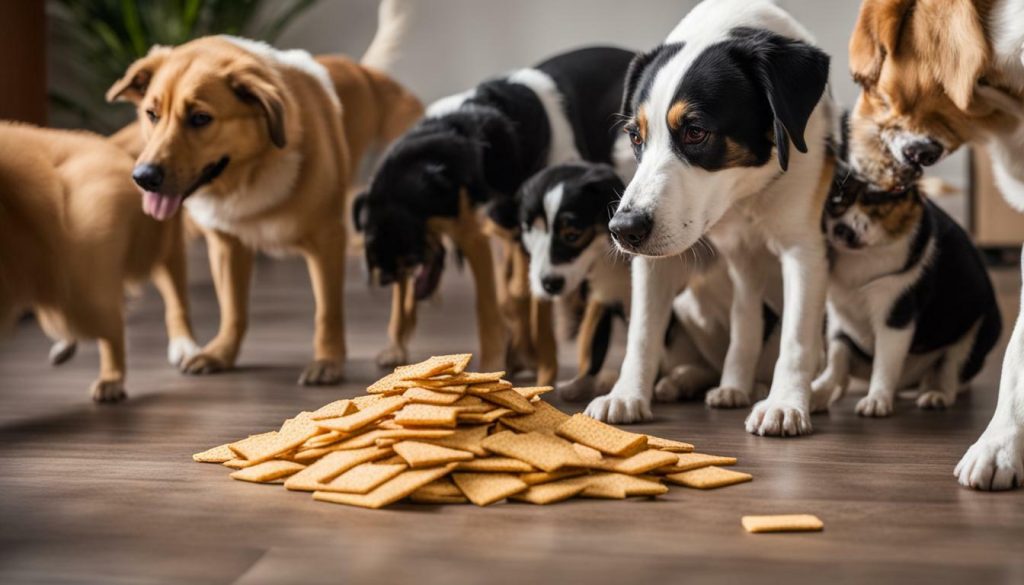
While it may be tempting to share your favorite snacks with your furry friend, it’s crucial to prioritize their health by being aware of the potential risks associated with feeding them Wheat Thins. While Wheat Thins are not toxic to dogs, they can have negative health impacts over time.
One of the main concerns with Wheat Thins is their high sodium content. Dogs have different dietary needs than humans, and excessive sodium intake can lead to issues such as elevated blood pressure, electrolyte imbalance, and hypernatremia.
Additionally, some dogs may have allergies to wheat. Feeding them Wheat Thins can trigger allergic reactions, which may manifest as itchy skin, hair loss, digestive issues, or other symptoms. It’s important to be aware of these potential allergies and monitor your dog’s response to wheat-based snacks.
Sugar, artificial preservatives, and colorings in Wheat Thins are also not beneficial for dogs. These additives can contribute to health issues like obesity, dental problems, and gastrointestinal discomfort. It’s best to limit your dog’s consumption of such ingredients.
In conclusion, if you choose to give your dog Wheat Thins, it should only be in very small quantities and as an occasional treat. It’s important to consider healthier alternatives that are specifically made for canine consumption. Always consult with a veterinarian if your dog consumes a large amount of Wheat Thins or experiences any abnormal symptoms.
FAQ
Can dogs eat Wheat Thins?
While Wheat Thins are not toxic to dogs, it’s not recommended to feed them to your furry friend regularly. They contain high amounts of sodium, which can lead to health issues such as high blood pressure and electrolyte imbalance over time.
Are Wheat Thins safe for dogs?
Wheat Thins can have negative health impacts on dogs when consumed in large quantities or on a regular basis. Their high sodium content and potential wheat allergies can cause various health issues over time. It’s always best to opt for healthier alternatives or consult with a veterinarian.
What are the risks of feeding Wheat Thins to dogs?
Feeding Wheat Thins to dogs can pose risks such as elevated blood pressure, electrolyte imbalance, hypernatremia, and potential allergic reactions. Additionally, the sugar, artificial preservatives, and colorings in Wheat Thins are not beneficial for dogs and can contribute to health issues like obesity.
Can dogs have allergies to wheat?
Yes, some dogs may have allergies to wheat. Feeding them Wheat Thins can trigger allergic reactions, including itchy skin, hair loss, digestive issues, and other symptoms. If you suspect your dog has a wheat allergy, it’s important to identify and avoid wheat-based products.
Are there healthier alternatives to Wheat Thins for dogs?
Yes, there are plenty of healthier alternatives to Wheat Thins that can be safely enjoyed by dogs. Consider dog-friendly snacks made with whole grains, lean meats, fruits, or vegetables. Always check for any potential allergens and avoid snacks with excessive salt, sugar, or artificial additives.
How many Wheat Thins can dogs have?
Dogs should only be given very small quantities of Wheat Thins as an occasional treat. It’s important to remember that moderation is key when it comes to any human food for dogs. Consult with your veterinarian to determine the appropriate serving size for your dog’s size and health condition.
When should I consult a veterinarian if my dog eats Wheat Thins?
If your dog consumes a large amount of Wheat Thins or experiences any abnormal symptoms after consuming them, it is advisable to consult a veterinarian. They can provide professional advice and guidance based on your dog’s specific situation.






